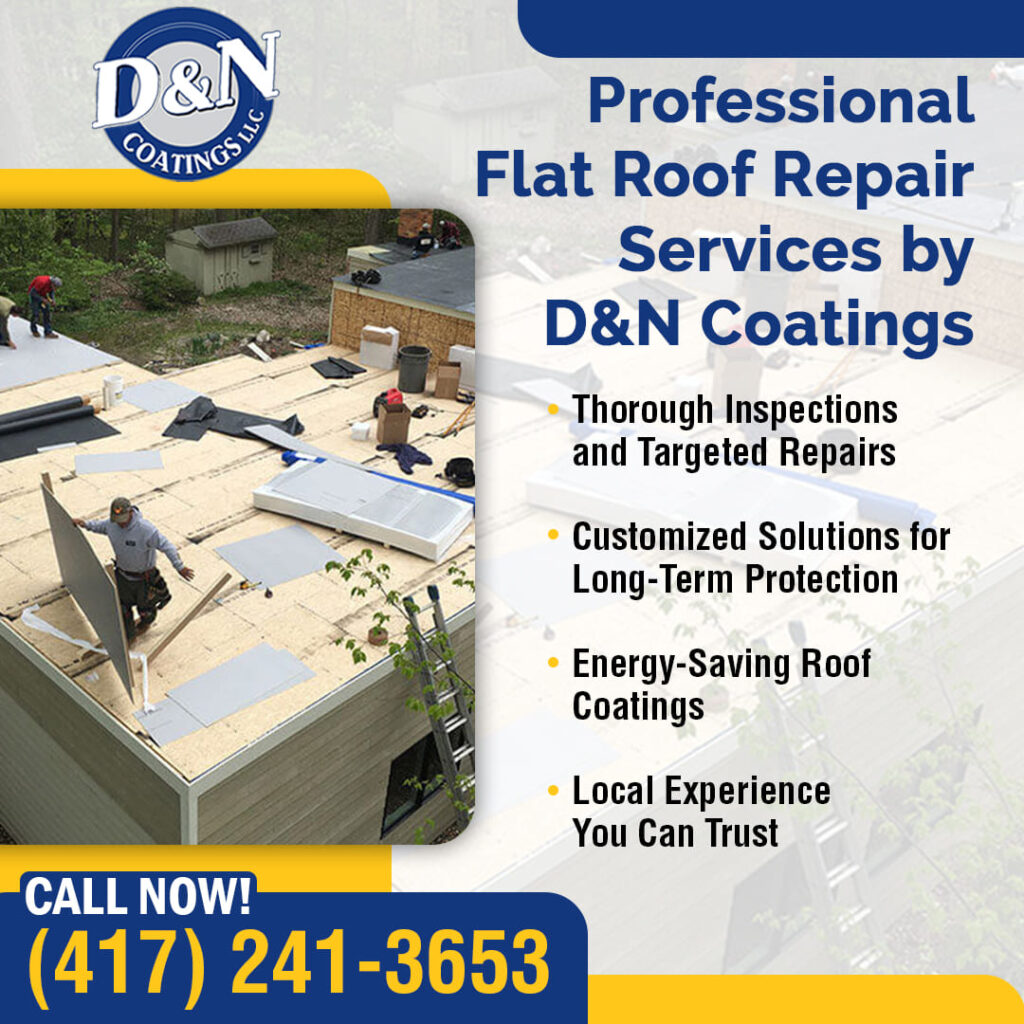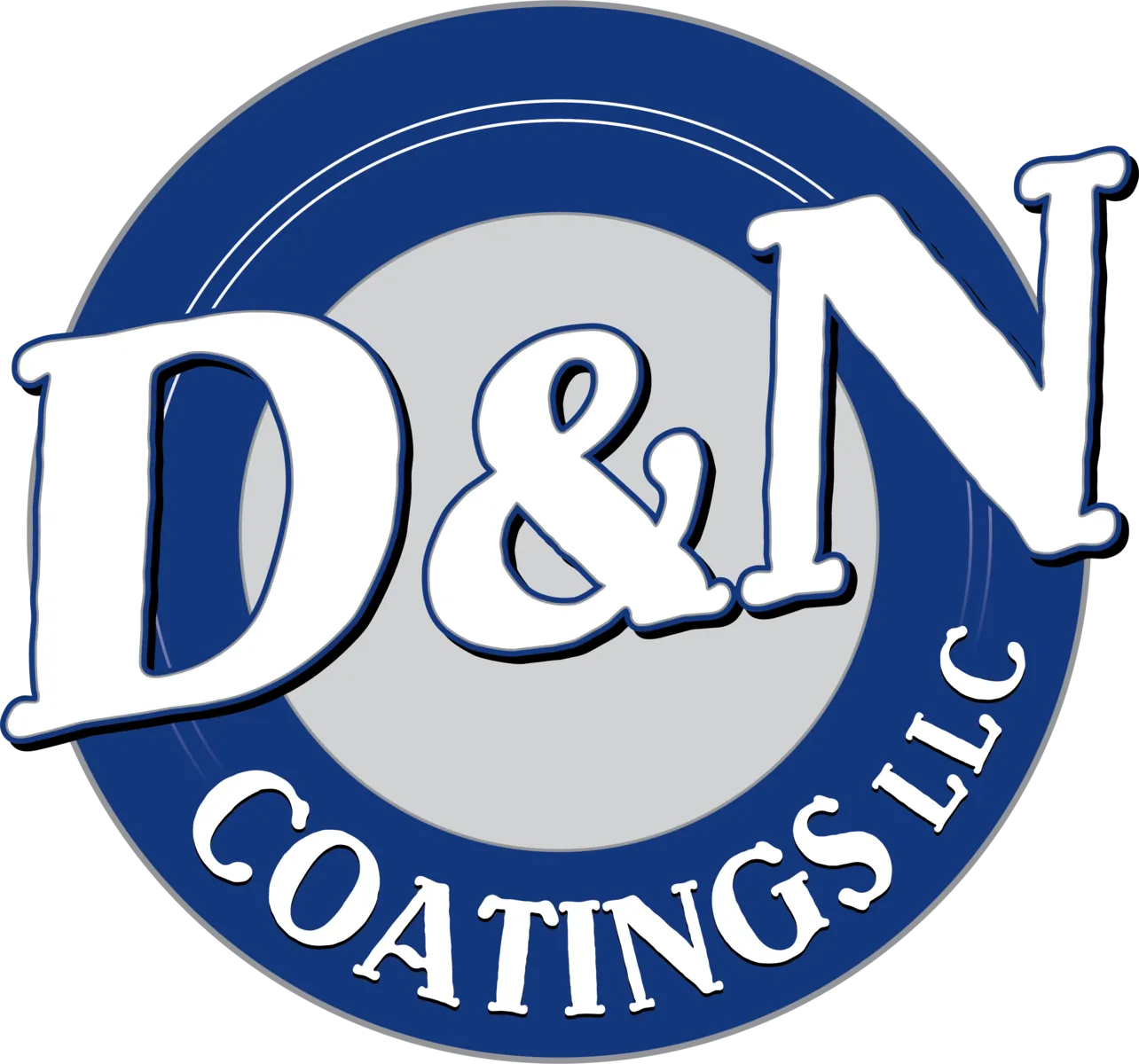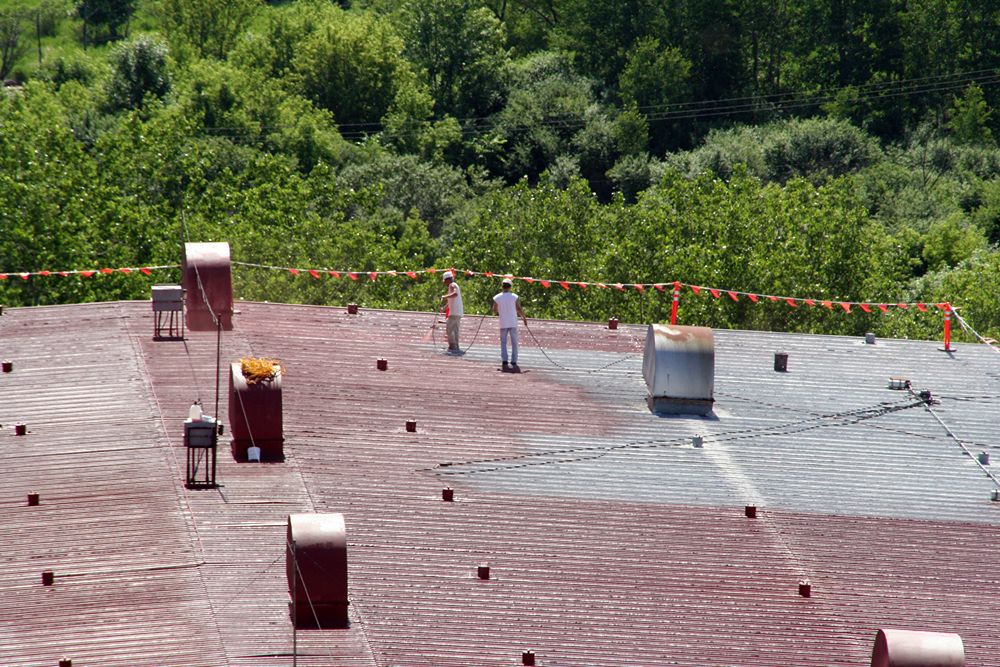Flat roofs are widely used on commercial buildings, offering a practical design but requiring consistent care to remain effective. Identifying signs of a failing flat roof early can help avoid expensive damage and maintain the building’s integrity. Business owners and property managers should be aware of common warning signs to take prompt action.
At D&N Coatings, we provide professional commercial flat roof repair services across Missouri. As a reliable commercial roofing contractor, we assist property owners in spotting issues before they worsen. This article highlights six key red flags that suggest a flat roof may be failing. Knowing these signs will help you address problems quickly, protect your property, and reduce costly repairs down the line.
Why Flat Roof Failure Isn’t Always Obvious
Flat roofs present unique challenges because damage often begins where it’s hard to see. For building owners and managers working with a trusted commercial roofing contractor, comprehending why these problems stay hidden is key to avoiding costly repairs and protecting your commercial property.
What Makes Flat Roof Damage Hard to Detect
Flat roof damage typically starts beneath the surface. Moisture can become trapped under the top layer of roofing materials like single-ply membranes, commonly used in commercial roofing. This hidden moisture slowly weakens the roof’s structure over time without visible warning signs.
The surface may look intact even as internal damage worsens. Early indicators like small cracks, blistering (raised areas caused by trapped air or moisture), or soft spots may be easy to overlook. These subtle signs don’t always show up immediately, which is why regular inspections by a professional are essential.
Examples of commonly missed damage include blistering on the membrane surface, soft areas that feel spongy when walked on, water stains on ceiling tiles below, and musty odors caused by moisture trapped inside insulation.
Importance of Early Detection
Waiting until leaks become visible inside your building increases the risk of major damage. By the time water shows up indoors, the roof’s integrity may already be compromised. Repairing damage at this stage often requires extensive flat roof repair or even full replacement.
Identifying early signs helps you avoid expensive repairs and interruptions to your business operations. Keep an eye out for surface wear, pooling water, or debris buildup that could trap moisture. Scheduling regular maintenance inspections, ideally twice a year, in spring and before winter, with your commercial roofing contractor is a smart strategy.
Early detection protects the long-term strength of your commercial flat roof and helps you stay ahead of costly emergencies.

Six Indicators That Your Flat Roof May Be Breaking Down
Flat roofs often hide early damage beneath the surface, making it difficult to spot problems until they worsen. Recognizing these signs can help you act quickly and protect your investment. It can also extend the lifespan of your roof with professional flat roof repair from a trusted commercial roofing contractor.
1. Standing Water That Lingers After Rain
What Causes Ponding Water
Standing water on a flat roof is usually the result of poor drainage or surface irregularities. Flat spots, blocked drains, or insufficient slope allow rainwater to collect instead of flowing off the roof. This water may remain for days, especially if debris or ice is present in the drainage system.
Why It’s a Problem
Trapped water slowly degrades the roofing membrane and underlying materials. Moisture that doesn’t drain begins to weaken seams, soak into insulation, and trigger algae or mold. Over time, this constant saturation compromises the roof’s ability to resist leaks. Even areas that appear dry on the surface may be absorbing moisture underneath, creating a path to internal water damage.
2. Blisters, Bubbles, or Surface Deformation
How These Forms
Blisters on a flat roof develop when air or moisture becomes trapped between roofing layers. This is often caused by improper sealing, aging adhesives, or heat-related expansion. You may notice raised areas that feel soft underfoot or change shape depending on temperature.
What Happens if Ignored
If these blisters burst, they create weak spots where water enters easily. Once a blister breaks open, moisture begins to infiltrate the roof system. This can lead to deeper separation between layers, speeding up material failure and increasing the risk of future leaks, especially after storms or freeze-thaw cycles.
3. Water Marks or Stains Inside the Building
What They Indicate
Ceiling or wall stains usually mean a leak has already passed through the roof system. These marks tend to appear around vents, skylights, or outer walls. Often brown or yellow, they suggest that water has traveled through insulation and interior materials before becoming visible.
Consequences of Interior Water Damage
By the time stains appear indoors, the roof has likely been leaking for weeks or months. Water damage inside a commercial building can impact insulation, drywall, electrical systems, and air quality. Fixing the visible stain does nothing unless the roof breach is also resolved. Early detection helps limit repair costs to the roof alone.
4. Cracked or Deteriorated Seams
What Causes Seam Issues
Seams often fail due to temperature swings, foot traffic, or aging adhesives. Materials expand and contract with weather changes. When adhesives lose flexibility, seams begin to crack or separate. Rooftop equipment service can also cause wear in seam-heavy areas.
How This Leads to Leaks
Water easily enters through even a small crack in the seam. These entry points let moisture bypass the protective membrane. Once inside, water spreads across the substrate, soaking insulation and rusting fasteners. Seam cracks usually widen over time, turning minor leaks into major failures.
5. Plant or Fungal Growth on the Roof
What It Suggests
Vegetation grows where moisture remains long enough to support it. Moss, weeds, or fungi often take root in areas with poor drainage or persistent dampness. These growths are more than cosmetic; they point to long-term water retention that the roof system has failed to manage.
How Growth Accelerates Roof Breakdown
Roots and organic buildup hold water close to the surface. This constant exposure causes roofing materials to soften, separate, or decay. In some cases, roots penetrate the membrane and spread beneath it. Algae and mold can also increase membrane temperature, adding more stress during hot weather.
6. HVAC and Roof Equipment Anchors Coming Loose
Why Equipment Matters
Heavy rooftop systems like HVAC units place constant pressure on the roof. Over time, vibration and wind movement loosen the fasteners that hold these units in place. Temperature shifts can also cause movement in the flashing or curbing around them.
Early Signs of Anchor Failure
Loose anchors often create tears or gaps in the membrane around equipment. You might notice shifting units, visible cracks, or pooled water near curbs. If left unaddressed, water enters through these breaches and spreads to adjacent areas. Repairing both the equipment base and affected membrane early helps prevent deeper structural issues.
Working with a reliable commercial roofing contractor for regular inspections and timely commercial flat roof repair makes sure that your flat roof stays in good condition and performs as intended.

What Property Managers Can Do Immediately
Flat roof problems often start quietly and grow unnoticed. Once you spot even minor signs of trouble, acting quickly is essential to prevent expensive repairs and protect your commercial property’s value. Here’s how property managers can take immediate, effective steps to address potential flat roof issues.
Documenting the Roof Condition
Begin by thoroughly recording the current state of your roof. When inspecting, use a camera or smartphone to take clear, detailed photos of any visible concerns. Pay close attention to standing water, blisters or bubbles on the surface, debris buildup, or any plant growth. If you notice water stains or discoloration inside the building, capture those images as well.
Keep a dated log that notes where and when each issue was found, describing its severity. Conduct these inspections regularly, monthly is ideal, and compare your records over time. This documentation forms a valuable history of your roof’s condition, which can help communicate problems clearly to a trusted commercial roofing contractor, insurance providers, and building owners. Visual evidence also supports timely decisions for flat roof repair before issues escalate.
Scheduling a Professional Inspection
Don’t delay calling in roofing experts once you suspect damage. A qualified commercial roofing contractor can identify issues that might be invisible to an untrained eye. Early professional inspections uncover minor damage and allow for targeted repairs rather than costly full replacements.
Regular inspections also help you adhere to maintenance schedules or warranty requirements. These checkups clarify what repairs are urgent and which areas need monitoring. Engaging a professional early makes sure that your flat roof continues to perform reliably and avoids unexpected failures.
D&N Coatings: Trusted Flat Roof Repair for Commercial Properties
D&N Coatings, based in Hartville, MO, specializes in flat roof repair tailored to the unique needs of commercial buildings in Springfield and Central Missouri. Flat roofs require specific expertise because their design creates challenges that differ from pitched roofs. Our goal is to provide effective, durable solutions that protect your investment while keeping repair costs manageable.
Thorough Inspections
Our team begins every project with a detailed inspection using industry-leading tools.These devices allow us to detect hidden moisture and membrane damage that is not visible to the naked eye.
Since flat roof damage often starts beneath the surface, early detection is critical to preventing larger problems. By identifying trouble spots early, we can recommend targeted repairs that address the root cause without unnecessary disruption or expense.
Customized Repair Solutions to Extend Roof Life
D&N Coatings understands that every flat roof is different. Whether your roof is showing signs of blisters, seam cracks, or membrane wear, we offer repair solutions that fit your specific situation.
This might include patching damaged areas, resealing seams, or applying roof coatings designed to reinforce your roofing membrane. Our repairs aim to restore the roof’s integrity and extend its useful life, helping you avoid costly full replacements.
Energy-Efficient Coatings for Long-Term Benefits
In addition to repairs, D&N Coatings applies reflective coatings that help manage heat buildup on flat roofs. These coatings reduce your building’s cooling costs by reflecting sunlight and lowering roof temperatures. This improves energy efficiency and also protects roofing materials from premature aging caused by UV exposure and temperature extremes.
Local Expertise You Can Count On
As a commercial roofing contractor based in Missouri, D&N Coatings has a deep understanding of local weather conditions and how they impact flat roofs. Our skilled craftsmen are committed to quality and reliability, ensuring every project meets industry standards and your expectations.
Businesses throughout Springfield and the surrounding area trust D&N Coatings for professional, responsive flat roof repair and commercial flat roof repair services. By choosing D&N Coatings, you’re investing in lasting protection and peace for your commercial property’s roof.
Protect Your Commercial Flat Roof Today!
Don’t wait for minor issues to turn into costly repairs. Trust D&N Coatings, your local commercial roofing contractor in Hartville, MO, to provide professional flat roof repair and maintenance services tailored to your building’s needs.
Contact us today at (417) 241-3653 to schedule a thorough inspection or to discuss your flat roof repair options. Our team is ready to help you safeguard your commercial property with skilled craftsmanship and dependable service.

